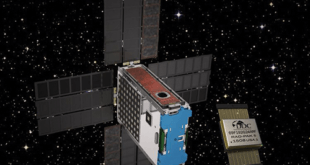Introduction The dream of exploring the cosmos beyond our solar system has captivated the imagination of scientists, visionaries, and space enthusiasts for decades. However, the vast distances and limitations of traditional rocket propulsion have posed significant challenges to interstellar travel. Enter quantum propulsion and its revolutionary concept of light-thrust engines, …
Read More »Unleashing the Power of Satellites: How DARPA Oversight’s Software is Enabling Hypersonic Missile Tracking and Targeting by Satellite Constellations
Introduction In the ever-evolving landscape of global security, staying ahead of advanced missile technologies has become a paramount concern for military agencies worldwide. Hypersonic missiles, characterized by their extreme speed and unpredictable flight paths, pose a significant challenge for conventional defense systems. However, the Defense Advanced Research Projects Agency (DARPA) …
Read More »Revolutionizing Defense Manufacturing: DARPA’s B-SURE Initiative for Biomanufacturing in Space on Orbital and Lunar Missions
Introduction As humanity continues its quest for space exploration, the potential for conducting advanced biomanufacturing in space is capturing the attention of scientists and researchers. The Defense Advanced Research Projects Agency (DARPA) has embarked on a groundbreaking initiative known as B-SURE (Biotechnology for the Exploration of Space using Unique Readiness …
Read More »DARPA Zenith: Advancing Space Situational Awareness(SSA) with Liquid Mirror Telescopes
Introduction: The exponential growth of space objects, including orbital debris, poses an increasing risk of collisions in Earth’s orbit. With over 100 million objects less than 1 cm in size, the safety of operational satellites is a significant concern. Any of debris objects can cause harm to an operational spacecraft, …
Read More »Connecting When It Matters Most: Emergency Satellite Services and Disaster Relief
Introduction: In times of natural disasters and humanitarian crises, connecting with affected communities and coordinating relief efforts is critical for saving lives and minimizing damages. However, traditional communication infrastructure often fails or becomes overwhelmed during these emergencies, leaving communities isolated and responders struggling to assess the situation. In such dire …
Read More »Unveiling the Stars: Deep Space Technologies Trends and Market Insights
Introduction: The exploration of deep space has always captivated the imagination of humanity. As our understanding of the cosmos expands, so too does the potential for technological advancements that push the boundaries of what is possible. In this blog article, we will delve into the exciting world of deep space …
Read More »NASA Innovative Advanced Concepts (NIAC) Program
The NASA Innovative Advanced Concepts (NIAC) program is an American government-funded program run by NASA that funds and supports early-stage technology development. The goal of the program is to invest in transformative ideas that have the potential to change the future of aerospace, and to explore concepts that are considered …
Read More »High Reliability and Radiation-Hardened Memories: Safeguarding Data for Space and Aerospace Applications
Introduction In the realm of space exploration and aerospace technology, the reliability and integrity of data are paramount. The extreme conditions of space, including high radiation levels and temperature variations, present significant challenges to electronic systems. To ensure the safe and accurate operation of critical systems in these harsh environments, …
Read More »Rising rocket launches damaging ozone and altering climate
In 2021, there were 146 space launches, out of which 51 were from the U.S., 55 from China, and 25 from Russia. The launches are expected to rise, which can deteriorate the ozone layer, thus, creating a detrimental effect on the Earth’s climate. So far, the environmental impacts of …
Read More »Space tourism for Leisure and Buisness
Space tourism is human space travel for recreational purposes. There are several different types of space tourism, including orbital, suborbital, and lunar space tourism. Space Tourism Market lets travelers travel in and across the Earth’s orbit for leisure, recreation, or significant business purposes. In addition, it will probably make travel …
Read More » International Defense Security & Technology Your trusted Source for News, Research and Analysis
International Defense Security & Technology Your trusted Source for News, Research and Analysis




